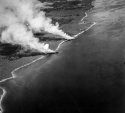Jura, you will find this interesting regarding Battleship on Battleship surface engagements in world War II.
In the Pacific there were really only two. One was the 4th Battle off Savo Island by Guadalcanal on the evening of November 14, into the early morning hours of November 15, 1942. The other was the battle of Suriago Strait during the evening of October 25, 1944.
Here's some info on the first one, off Savo Island near Guadalcanal:
4th Battle of Savo Island (off Guadalcanal), November 14-15, 1942
Imperial Japanese Navy:
1 x Battleship Kirishima
2 x Hevy crusiers
2 x Light cruisers
9 x destroyers
4 x Tranports
US Navy:
2 x Battleshipa Washington and South dakota
4 x Destroyers

Japanese heavy cruiser and battleship Kirishima sailing towards Guadalcanal, November 14, 1942
Kirishima and the two heavy cruisers were detached as a bombarment group for Henderson field. The two light cruisers and four destroyers screened these vessels, the four transports and other destroyers were to perform the landing of einforcements on Gualdalcanal at first light.
The four US destroyers screend the battleships forward, and at 23:22 began an engagement with the Japanese destroyers and light cruisers. Three of them were sunk, the other damaged. But they achieved their mission of engaging the forwad Japanese forces, allowing the battleships to pass and engage the principle Japanese surface units. One japanese destroyer was severally damaged as the battleships passed by.
The Japanese battleship Kirishima and the two heavy cruisers engaged Washington and South Dakota beginning just before midnight on the 14th. The Japanese ships located and concentrated on south Dakota who had already experienced a non-combat related electrical problem which had seriously impacted her communications and turret operations. South Dakota took twenty-five medium caliber and one large caliber hits that knocked out all communications and her gunfire control, those hits also set areas of her upper decks on fire. At 00:17 on the 15th of November, the south Dakota broke off and steered away from the battle, but did scoree a few hits on Kirishima, though nothing major. South Dakota's commanding officer later summarized, "The Japanese had rendered one of our new battleships, the South Dakota, deaf, dumb, blind, and impotent."

USS Washington firing on Kirishima in the very early hours of November 15, 1942
In the mean time the Washington was able to approach, undetected to within 9,000 yards of Kirishima and open fire. Washington fired a total of seventy-five 16-inch and one hundred and seven 5-inch rounds during the engagment and struck Kirishima with at least nine 16-inch rounds and upwards of forty secondary, 5-inch rounds. Several of the hits were below the waterline on Kirishima. This punding caused massive and severe damage to Kirishima, leaving her burning all along her upper deck, taking on massive amounts of water, and with her rudder jammed, circling uncontrolled to port.
The Japanese turned away.
The severelly damaged Japanese destroyer and the fatally damaged Kirishima were scuttled and sank by 03:00 hours of Novmber 15th. The rest of the japanese surface group departed so as to be away from Guadalcanal's Henderson Field by daylight. The four transports beached themselves on Guadlalcanal and were detroyed the next day by air attack and destroyer gun fire.

Japanese trasnports buring oin the beach of Gualdalcanal, November 15, 1942
The result:
Imperial Japanese Navy:
Lost Battleship Kirishima
Lost one desttroyer
Lost four tranports
US Navy:
Lost three destroyers
Damged Battleship South Dakota
I think I will start a separate thread about World War II Battleship on Battleship surface engagements.





